Evaluation of the Smart City and Analysis of Its Spatial–Temporal Characteristics in China: A Case Study of 26 Cities in the Yangtze River Delta Urban Agglomeration
Abstract
:1. Introduction
1.1. Background
1.2. Literature Review
1.3. Research Objectives and Significance
2. Methodology
2.1. Selecting the Evaluation Indicators of the SC
2.2. Establishing the Evaluation Model of the SC
2.2.1. Determining Weights of Evaluation Indicators of the SC through the EWM
- Data normalization.
- b.
- The entropy of the i-th indicator.
- c.
- The weight of the i-th indicator.
2.2.2. Calculating the SCL
2.3. Analyzing the Spatial–Temporal Characteristics of the SC in China
- Global spatial autocorrelation
- b.
- Local spatial autocorrelation
3. Case Study
3.1. Study Area
3.2. Data Sources
4. Results
4.1. Evaluation Results of SCs in the YRDUA
4.1.1. Weights of Evaluation Indicators through the EWM
4.1.2. Calculation Results of the SCL in the YRDUA
4.2. Spatial–Temporal Characteristics of the SC in the YRDUA
4.2.1. Spatial–Temporal Distribution of the SCL in the YRDUA
4.2.2. Results of Global Spatial Autocorrelation Analysis
4.2.3. Results of Local Spatial Autocorrelation Analysis
5. Discussion
5.1. Analysis of Temporal Characteristics of the SC in China
5.2. Analysis of Spatial Characteristics of the SC in China
5.2.1. Analysis of Spatial Distribution of the SCL in the YRDUA
5.2.2. Analysis of Global Spatial Autocorrelation for the SC
5.2.3. Analysis of Local Spatial Autocorrelation for the SC
5.3. Applicability of the Comprehensive Evaluation Framework for the SC
5.4. Suggestions for Promoting the Development of the SC
6. Conclusions
Supplementary Materials
Author Contributions
Funding
Institutional Review Board Statement
Informed Consent Statement
Data Availability Statement
Acknowledgments
Conflicts of Interest
Appendix A
| Individual Characteristics | Items | Number | Percentage (%) |
|---|---|---|---|
| Gender | Male | 11 | 61.11% |
| Female | 7 | 38.89% | |
| Education level | Doctorate degree | 5 | 27.78% |
| Master’s degree | 8 | 44.44% | |
| Others | 5 | 27.78% | |
| Occupation | College teachers | 4 | 22.22% |
| Government employee | 1 | 5.56% | |
| Manager of the enterprise | 7 | 38.89% | |
| Others | 6 | 33.33% | |
| Working experience | More than 5 years | 3 | 16.67% |
| 3 to 5 years | 3 | 16.67% | |
| 1 to 3 years | 5 | 27.78% | |
| Less than 1 year | 7 | 38.89% |
| Name | 2017 | 2018 | 2019 | 2020 |
|---|---|---|---|---|
| Shanghai | 0.567995 | 0.631323 | 0.680538 | 0.737779 |
| Nanjing | 0.267547 | 0.367179 | 0.390667 | 0.403665 |
| Wuxi | 0.204699 | 0.217442 | 0.231015 | 0.240458 |
| Changzhou | 0.128006 | 0.129307 | 0.213915 | 0.222444 |
| Suzhou | 0.19847 | 0.220549 | 0.319073 | 0.351161 |
| Nantong | 0.116896 | 0.116066 | 0.196351 | 0.202543 |
| Yancheng | 0.077572 | 0.096202 | 0.101476 | 0.110135 |
| Yangzhou | 0.166043 | 0.175795 | 0.166275 | 0.174337 |
| Zhenjiang | 0.070273 | 0.079065 | 0.079245 | 0.088851 |
| Taizhou | 0.087516 | 0.090406 | 0.182291 | 0.18961 |
| Hangzhou | 0.286414 | 0.336396 | 0.387886 | 0.49432 |
| Ningbo | 0.152948 | 0.242115 | 0.259139 | 0.280063 |
| Jiaxing | 0.132669 | 0.119759 | 0.124854 | 0.141828 |
| Huzhou | 0.098263 | 0.121044 | 0.181338 | 0.195055 |
| Shaoxing | 0.108471 | 0.134528 | 0.11819 | 0.210991 |
| Jinhua | 0.126169 | 0.147271 | 0.181366 | 0.247507 |
| Zhoushan | 0.124101 | 0.125575 | 0.132542 | 0.208226 |
| Taizhou | 0.092485 | 0.094899 | 0.102606 | 0.183275 |
| Hefei | 0.188895 | 0.21303 | 0.222788 | 0.251058 |
| Wuhu | 0.073452 | 0.083263 | 0.088185 | 0.181788 |
| Ma’anshan | 0.074637 | 0.164544 | 0.177831 | 0.192791 |
| Tongling | 0.048364 | 0.060059 | 0.066037 | 0.144774 |
| Anqing | 0.044448 | 0.050895 | 0.060283 | 0.068534 |
| Chuzhou | 0.046308 | 0.059889 | 0.07844 | 0.0824 |
| Chizhou | 0.03258 | 0.046279 | 0.048459 | 0.052766 |
| Xuancheng | 0.049711 | 0.132861 | 0.131877 | 0.142678 |
References
- Ismagilova, E.; Hughes, L.; Dwivedi, Y.K.; Raman, K.R. Smart cities: Advances in research—An information systems perspective. Int. J. Inf. Manag. 2019, 47, 88–100. [Google Scholar] [CrossRef]
- Sun, J.; Wang, Y.; Liu, S.; Dehghani, A.; Xiang, X.; Wei, J.; Wang, X. Mechanical, chemical and hydrothermal activation for waste glass reinforced cement. Constr. Build. Mater. 2021, 301, 124361. [Google Scholar] [CrossRef]
- Zhang, Y.; Zhang, Y.; Zhang, H.; Zhang, Y. Evaluation on new first-tier smart cities in China based on entropy method and TOPSIS. Ecol. Indic. 2022, 145, 109616. [Google Scholar] [CrossRef]
- Makhdoom, I.; Zhou, I.; Abolhasan, M.; Lipman, J.; Ni, W. PrivySharing: A blockchain-based framework for privacy-preserving and secure data sharing in smart cities. Comput. Secur. 2020, 88, 101653. [Google Scholar] [CrossRef]
- Neirotti, P.; De Marco, A.; Cagliano, A.C.; Mangano, G.; Scorrano, F. Current trends in Smart City initiatives: Some stylised facts. Cities 2014, 38, 25–36. [Google Scholar] [CrossRef]
- Shelton, T.; Zook, M.; Wiig, A. The ‘actually existing smart city’. Camb. J. Reg. Econ. Soc. 2015, 8, 13–25. [Google Scholar] [CrossRef]
- Huovila, A.; Bosch, P.; Airaksinen, M. Comparative analysis of standardized indicators for Smart sustainable cities: What indicators and standards to use and when? Cities 2019, 89, 141–153. [Google Scholar] [CrossRef]
- Bibri, S.E.; Krogstie, J. Smart sustainable cities of the future: An extensive interdisciplinary literature review. Sustain. Cities Soc. 2017, 31, 183–212. [Google Scholar] [CrossRef]
- Shafiq, M.; Tian, Z.; Sun, Y.; Du, X.; Guizani, M. Selection of effective machine learning algorithm and Bot-IoT attacks traffic identification for internet of things in smart city. Future Gener. Comput. Syst. 2020, 107, 433–442. [Google Scholar] [CrossRef]
- Ullah, Z.; Al-Turjman, F.; Mostarda, L.; Gagliardi, R. Applications of Artificial Intelligence and Machine learning in smart cities. Comput. Commun. 2020, 154, 313–323. [Google Scholar] [CrossRef]
- Ma, G.; Sun, J.; Aslani, F.; Huang, Y.; Jiao, F. Review on electromagnetic wave absorbing capacity improvement of cementitious material. Constr. Build. Mater. 2020, 262, 120907. [Google Scholar] [CrossRef]
- Klopp, J.M.; Petretta, D.L. The urban sustainable development goal: Indicators, complexity and the politics of measuring cities. Cities 2017, 63, 92–97. [Google Scholar] [CrossRef]
- Giffinger, R.; Haindlmaier, G.; Kramar, H. The role of rankings in growing city competition. Urban Res. Pract. 2010, 3, 299–312. [Google Scholar] [CrossRef]
- Huang, G.; Li, D.; Yu, L.; Yang, D.; Wang, Y. Factors affecting sustainability of smart city services in China: From the perspective of citizens’ sense of gain. Habitat Int. 2022, 128, 102645. [Google Scholar] [CrossRef]
- Shen, L.; Huang, Z.; Wong, S.W.; Liao, S.; Lou, Y. A holistic evaluation of smart city performance in the context of China. J. Clean. Prod. 2018, 200, 667–679. [Google Scholar] [CrossRef]
- Anand, A.; Winfred Rufuss, D.D.; Rajkumar, V.; Suganthi, L. Evaluation of Sustainability Indicators in Smart Cities for India Using MCDM Approach. Energy Procedia 2017, 141, 211–215. [Google Scholar] [CrossRef]
- Ozkaya, G.; Erdin, C. Evaluation of smart and sustainable cities through a hybrid MCDM approach based on ANP and TOPSIS technique. Heliyon 2020, 6, e05052. [Google Scholar] [CrossRef]
- Camero, A.; Alba, E. Smart City and information technology: A review. Cities 2019, 93, 84–94. [Google Scholar] [CrossRef]
- Lai, C.M.T.; Cole, A. Measuring progress of smart cities: Indexing the smart city indices. Urban Gov. 2023, 3, 45–57. [Google Scholar] [CrossRef]
- Yigitcanlar, T.; Kamruzzaman, M.; Buys, L.; Ioppolo, G.; Sabatini-Marques, J.; da Costa, E.M.; Yun, J.J. Understanding ‘smart cities’: Intertwining development drivers with desired outcomes in a multidimensional framework. Cities 2018, 81, 145–160. [Google Scholar] [CrossRef]
- Administration of Quality Supervision, Inspection, and Quarantine of the People’s Republic of China; The Standardization Administration of China. Evaluation Model and General Evaluation Indicator System for Smart Cities—Part 1: General FRAMEWORK and Requirements for Developing Evaluation Sub-Indicators. 2017. Available online: https://openstd.samr.gov.cn/bzgk/gb/Newgbinfo?Hcno=94a3d226fb1d802a5f2e348b0c4bedbc (accessed on 31 January 2023). (In Chinese)
- Liu, J.; Chen, N.; Chen, Z.; Xu, L.; Du, W.; Zhang, Y.; Wang, C. Towards sustainable smart cities: Maturity assessment and development pattern recognition in China. J. Clean. Prod. 2022, 370, 133248. [Google Scholar] [CrossRef]
- Wang, M.; Zhou, T. Understanding the dynamic relationship between smart city implementation and urban sustainability. Technol. Soc. 2022, 70, 102018. [Google Scholar] [CrossRef]
- Antwi-Afari, P.; Owusu-Manu, D.-G.; Ng, S.T.; Asumadu, G. Modeling the smartness or smart development levels of developing countries’ cities. J. Urban Manag. 2021, 10, 369–381. [Google Scholar] [CrossRef]
- Gavurova, B.; Kelemen, M.; Polishchuk, V. Expert model of risk assessment for the selected components of smart city concept: From safe time to pandemics as COVID-19. Socio-Econ. Plan. Sci. 2022, 82, 101253. [Google Scholar] [CrossRef]
- Kairui, Y. Intelligent evaluation approach for smart city based on DEA model: Taking Wuhan, China as an example. J. Intell. Fuzzy Syst. 2018, 35, 2667. [Google Scholar] [CrossRef]
- Li, Q.; Liu, L.; Guo, Z.; Vijayakumar, P.; Taghizadeh-Hesary, F.; Yu, K. Smart assessment and forecasting framework for healthy development index in urban cities. Cities 2022, 131, 103971. [Google Scholar] [CrossRef]
- Zhang, Y.; Liu, F.; Gu, Z.; Chen, Z.; Shi, Y.; Li, A. Research on Smart City Evaluation Based on Hierarchy of Needs. Procedia Comput. Sci. 2019, 162, 467–474. [Google Scholar] [CrossRef]
- Li, G.; Wang, Y.; Luo, J.; Li, Y. Evaluation on Construction Level of Smart City: An Empirical Study from Twenty Chinese Cities. Sustainability 2018, 10, 3348. [Google Scholar] [CrossRef]
- Sokolov, A.; Veselitskaya, N.; Carabias, V.; Yildirim, O. Scenario-based identification of key factors for smart cities development policies. Technol. Forecast. Soc. Change 2019, 148, 119729. [Google Scholar] [CrossRef]
- Silva, B.N.; Khan, M.; Han, K. Towards sustainable smart cities: A review of trends, architectures, components, and open challenges in smart cities. Sustain. Cities Soc. 2018, 38, 697–713. [Google Scholar] [CrossRef]
- Apanaviciene, R.; Vanagas, A.; Fokaides, P.A. Smart Building Integration into a Smart City (SBISC): Development of a New Evaluation Framework. Energies 2020, 13, 2190. [Google Scholar] [CrossRef]
- Macke, J.; Rubim Sarate, J.A.; de Atayde Moschen, S. Smart sustainable cities evaluation and sense of community. J. Clean. Prod. 2019, 239, 118103. [Google Scholar] [CrossRef]
- Shannon, C.E. A Mathematical Theory of Communication. Bell Syst. Tech. J. 1948, 27, 379–423. [Google Scholar] [CrossRef]
- Li, C.; Zhang, L.; Gu, Q.; Guo, J.; Huang, Y. Spatio-Temporal Differentiation Characteristics and Urbanization Factors of Urban Household Carbon Emissions in China. Int. J. Environ. Res. Public Health 2022, 19, 4451. [Google Scholar] [CrossRef]
- Tierney, B.T.; Tan, Y.; Kostic, A.D.; Patel, C.J. Gene-level metagenomic architectures across diseases yield high-resolution microbiome diagnostic indicators. Nat. Commun. 2021, 12, 2907. [Google Scholar] [CrossRef]
- Fu, X.M.; Ku, H.L.; Wu, W.Y.; Wang, L.X.; Chen, H.X.; Lin, C.Y.; Liu, Y. Spatial–temporal differentiation and convergence analysis of marine fishery innovation ability in China. Fish. Res. 2022, 254, 106393. [Google Scholar] [CrossRef]
- Cui, Y.; Qiu, K.; Li, G.; Jiang, H.; Kong, L. Spatiotemporal differentiation of energy eco-efficiency of shipbuilding industry in China. Ocean Coast. Manag. 2022, 230, 106347. [Google Scholar] [CrossRef]
- Liang, L.; Gong, P. Urban and air pollution: A multi-city study of long-term effects of urban landscape patterns on air quality trends. Sci. Rep. 2020, 10, 18618. [Google Scholar] [CrossRef]
- Tobler, W.R. A Computer Movie Simulating Urban Growth in the Detroit Region. Econ. Geogr. 1970, 46, 234. [Google Scholar] [CrossRef]
- Kumari, M.; Sarma, K.; Sharma, R. Using Moran’s I and GIS to study the spatial pattern of land surface temperature in relation to land use/cover around a thermal power plant in Singrauli district, Madhya Pradesh, India. Remote Sens. Appl. Soc. Environ. 2019, 15, 100239. [Google Scholar] [CrossRef]
- Ping, J.L.; Green, C.J.; Zartman, R.E.; Bronson, K.F. Exploring spatial dependence of cotton yield using global and local autocorrelation statistics. Field Crops Res. 2004, 89, 219–236. [Google Scholar] [CrossRef]
- Jiang, Y.; Lin, W.; Xu, D.; Xu, D. Spatio-temporal variation of the relationship between air pollutants and land surface temperature in the Yangtze River Delta Urban Agglomeration, China. Sustain. Cities Soc. 2023, 91, 104429. [Google Scholar] [CrossRef]
- Hu, H.; Lv, T.; Zhang, X.; Xie, H.; Fu, S.; Wang, L. Spatiotemporal coupling of multidimensional urbanization and resource–environment performance in the Yangtze River Delta urban agglomeration of China. Phys. Chem. Earth Parts A/B/C 2023, 129, 103360. [Google Scholar] [CrossRef]
- Yu, J.; Su, G.; Hirst, A.; Yang, Z.; Zhang, Y.; Li, Y. Identifying competing interest disclosures in systematic reviews of surgical interventions and devices: A cross-sectional survey. BMC Med. Res. Methodol. 2020, 20, 260. [Google Scholar] [CrossRef] [PubMed]
- Xiong, C.; Song, T.; Zhou, C. A Study on the Relationship between Artificial Intelligence and 5G Network Construction and the Level of Economic Development of Regional Cities. Wirel. Commun. Mob. Comput. 2022, 2022, 8020388. [Google Scholar] [CrossRef]
- Mao, C.; Wang, Z.; Yue, A.; Liu, H.; Peng, W. Evaluation of smart city construction efficiency based on multivariate data fusion: A perspective from China. Ecol. Indic. 2023, 154, 110882. [Google Scholar] [CrossRef]
- Yu, Y.; Zhang, N. Does smart city policy improve energy efficiency? Evidence from a quasi-natural experiment in China. J. Clean. Prod. 2019, 229, 501–512. [Google Scholar] [CrossRef]
- Luo, J.; Wang, Z.; Wu, M. Effect of place-based policies on the digital economy: Evidence from the Smart City Program in China. J. Asian Econ. 2021, 77, 101402. [Google Scholar] [CrossRef]
- Liu, K.; Meng, C.; Tan, J.; Zhang, G. Do smart cities promote a green economy? Evidence from a quasi-experiment of 253 cities in China. Environ. Impact Assess. Rev. 2023, 99, 107009. [Google Scholar] [CrossRef]
- Xu, H.; Jiao, M. City size, industrial structure and urbanization quality—A case study of the Yangtze River Delta urban agglomeration in China. Land Use Policy 2021, 111, 105735. [Google Scholar] [CrossRef]
- Lnenicka, M.; Nikiforova, A.; Luterek, M.; Azeroual, O.; Ukpabi, D.; Valtenbergs, V.; Machova, R. Transparency of open data ecosystems in smart cities: Definition and assessment of the maturity of transparency in 22 smart cities. Sustain. Cities Soc. 2022, 82, 103906. [Google Scholar] [CrossRef]
- Rejeb, A.; Rejeb, K.; Simske, S.; Treiblmaier, H.; Zailani, S. The big picture on the internet of things and the smart city: A review of what we know and what we need to know. Internet Things 2022, 19, 100565. [Google Scholar] [CrossRef]
- Wu, J.; Zhao, R.; Sun, J. What role does digital finance play in low-carbon development? Evidence from five major urban agglomerations in China. J. Environ. Manag. 2023, 341, 118060. [Google Scholar] [CrossRef]
- Yin, H.; Xiao, R.; Fei, X.; Zhang, Z.; Gao, Z.; Wan, Y.; Tan, W.; Jiang, X.; Cao, W.; Guo, Y. Analyzing “economy-society-environment” sustainability from the perspective of urban spatial structure: A case study of the Yangtze River delta urban agglomeration. Sustain. Cities Soc. 2023, 96, 104691. [Google Scholar] [CrossRef]
- Zhuang, L.; Ye, C. More sprawl than agglomeration: The multi-scale spatial patterns and industrial characteristics of varied development zones in China. Cities 2023, 140, 104406. [Google Scholar] [CrossRef]
- Wang, H.; Cheng, Z.; Zhu, D. Striving for global cities with governance approach in transitional China: Case study of Shanghai. Land Use Policy 2020, 90, 104288. [Google Scholar] [CrossRef]
- Zhong, Z.; Shen, L.; Wang, X. Evolution Characteristics and Influencing Factors of Smart Industry Space in the Yangtze River Delta Region. Econ. Geogr. 2021, 41. (In Chinese) [Google Scholar]
- Liu, T.; Zhou, B. Evaluation and obstacle factors of high-quality development in coastal cities along the Yangtze River. Ocean Coast. Manag. 2023, 244, 106818. [Google Scholar] [CrossRef]
- Tang, D.; Mao, M.; Shi, J.; Hua, W. The Spatio-Temporal Analysis of Urban-Rural Coordinated Development and Its Driving Forces in Yangtze River Delta. Land 2021, 10, 495. [Google Scholar] [CrossRef]
- Du, H.; Zhou, F. Study on the Layout of Ecological Space and the Integrated Management Mechanism of the Yangtze River Delta Urban Agglomeration. Land 2023, 12, 294. [Google Scholar] [CrossRef]
- Li, T.; Qi, Y.; Chen, M.; Hui, B.; Su, Y. Sub-central city’s green innovation in regional integration: Can it be a bridgehead even if it is far away? Ecol. Indic. 2023, 154, 110618. [Google Scholar] [CrossRef]
- Wang, F. Does the construction of smart cities make cities green? Evidence from a quasi-natural experiment in China. Cities 2023, 140, 104436. [Google Scholar] [CrossRef]
- Li, Z.; Tang, R.; Qiu, H.; Ma, L. Smart Energy Urban Agglomerations in China: The Driving Mechanism, Basic Concepts, and Indicator Evaluation. Sustainability 2023, 15, 11863. [Google Scholar] [CrossRef]
- Wu, Z.; Li, X.; Zhou, X.; Yang, T.; Lu, R. City Intelligence Quotient Evaluation System Using Crowdsourced Social Media Data: A Case Study of the Yangtze River Delta Region, China. ISPRS Int. J. Geo-Inf. 2021, 10, 702. [Google Scholar] [CrossRef]
- Li, C.; Zhang, X.; Dong, X.; Yan, Q.; Zeng, L.; Wang, Z. The impact of smart cities on entrepreneurial activity: Evidence from a quasi-natural experiment in China. Resour. Policy 2023, 81, 103333. [Google Scholar] [CrossRef]
- Yin, H.; Zhang, Z.; Wan, Y.; Gao, Z.; Guo, Y.; Xiao, R. Sustainable network analysis and coordinated development simulation of urban agglomerations from multiple perspectives. J. Clean. Prod. 2023, 413, 137378. [Google Scholar] [CrossRef]
- Nantong Municipal People’s Government Office. Nantong’s Big Data Development Plan (2019–2025). 2019. Available online: https://www.nantong.gov.cn/ntsrmzf/szfbwj/content/25144b62-b59e-4bc9-a2c1-d26f080c638a.html (accessed on 31 January 2023). (In Chinese)
- Zhou, D.; Xu, J.; Wang, L.; Lin, Z. Assessing urbanization quality using structure and function analyses: A case study of the urban agglomeration around Hangzhou Bay (UAHB), China. Habitat Int. 2015, 49, 165–176. [Google Scholar] [CrossRef]
- Guo, K.; Gu, Y. The Construction of Smart Tourism City and Digital Marketing of Cultural Tourism Industry under Network Propaganda Strategy. Secur. Commun. Netw. 2022, 2022, 4932415. [Google Scholar] [CrossRef]
- Qu, Y.; Li, J.; Wang, S. Green total factor productivity measurement of industrial enterprises in Zhejiang Province, China: A DEA model with undesirable output approach. Energy Rep. 2022, 8, 307–317. [Google Scholar] [CrossRef]
- Zhu, Y.; Yang, S.; Lin, J.; Yin, S. Spatial and Temporal Evolutionary Characteristics and Its Influencing Factors of Economic Spatial Polarization in the Yangtze River Delta Region. Int. J. Environ. Res. Public Health 2022, 19, 6997. [Google Scholar] [CrossRef]
- Chenhong, X.; Guofang, Z. The spatiotemporal evolution pattern of urban resilience in the Yangtze River Delta urban agglomeration based on TOPSIS-PSO-ELM. Sustain. Cities Soc. 2022, 87, 104223. [Google Scholar] [CrossRef]
- Ji, X.; Wang, K.; Ji, T.; Zhang, Y.; Wang, K. Coupling Analysis of Urban Land Use Benefits: A Case Study of Xiamen City. Land 2020, 9, 155. [Google Scholar] [CrossRef]
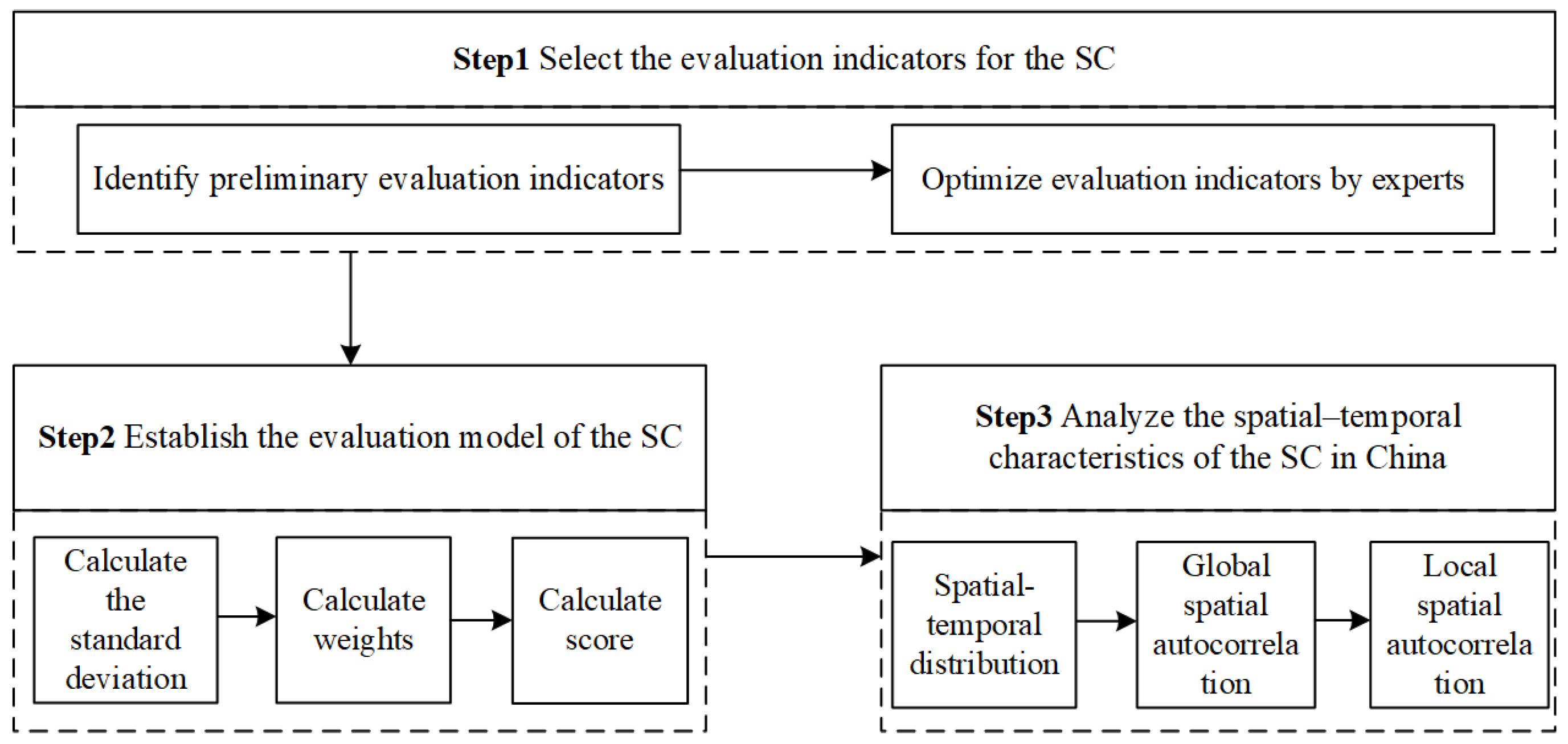
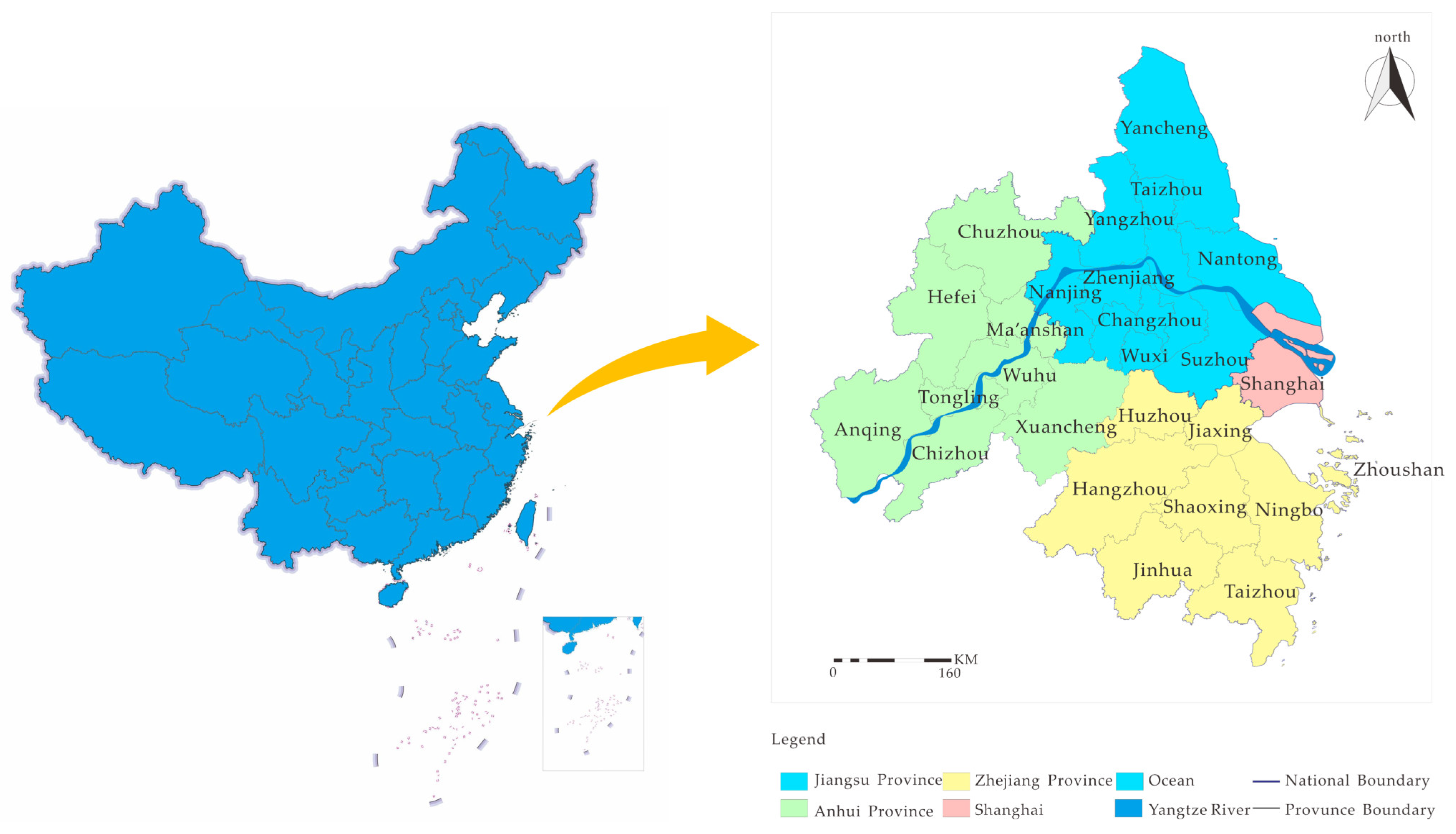
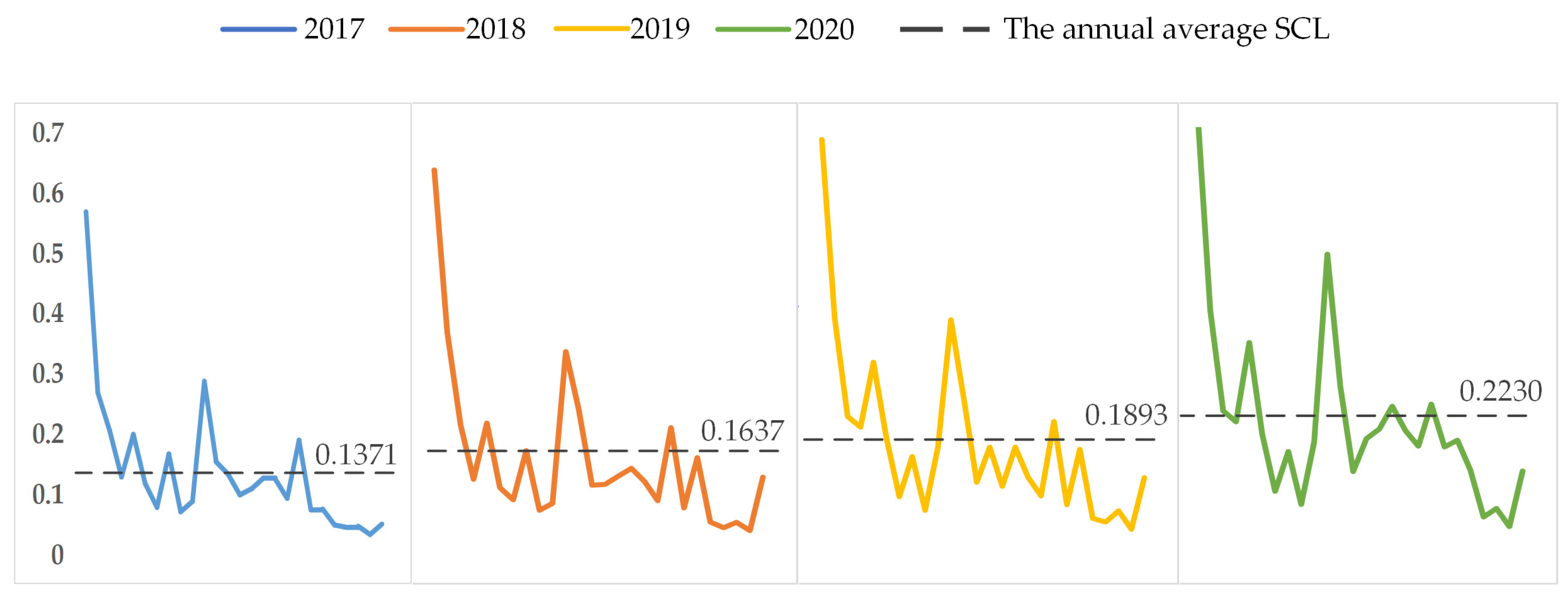
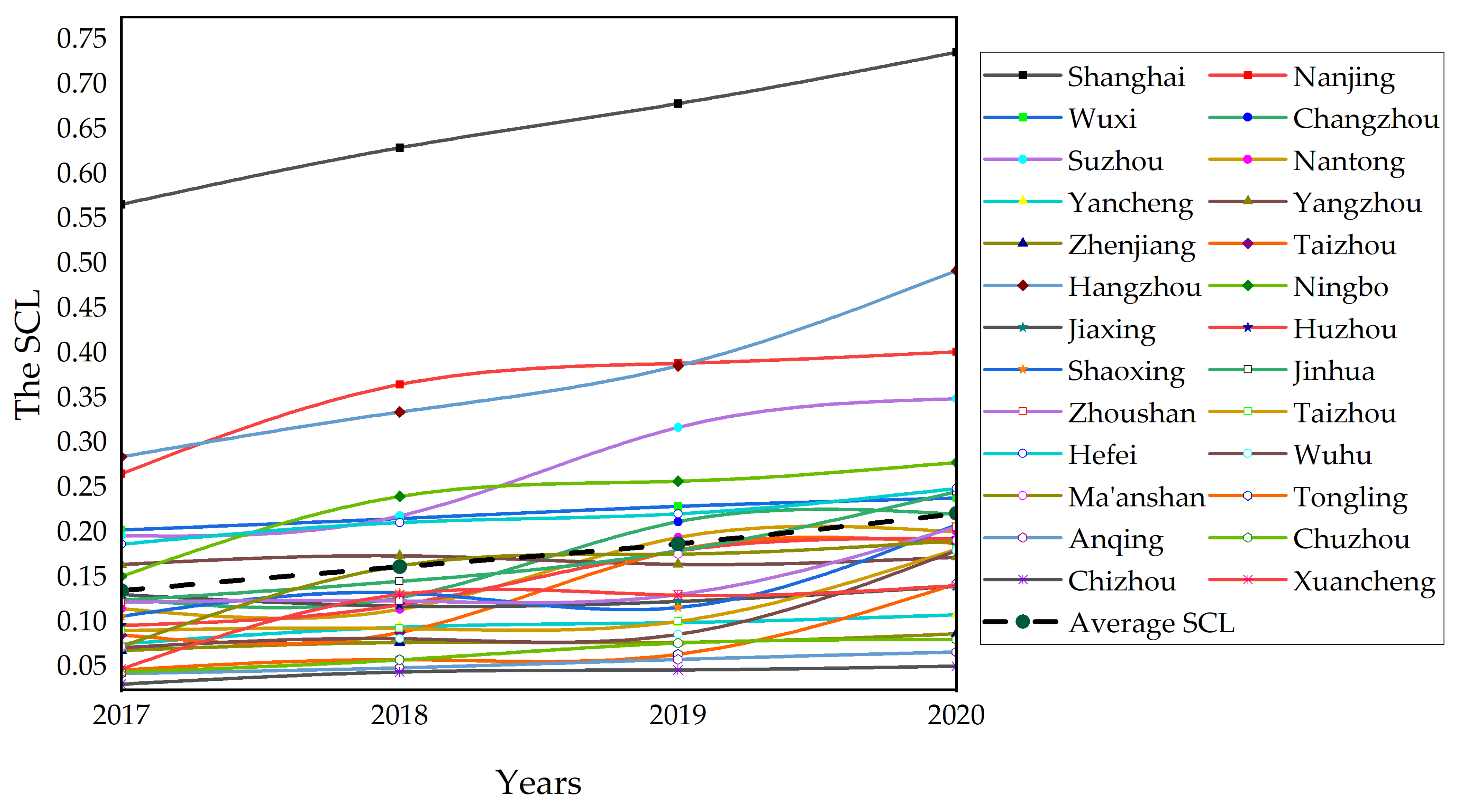
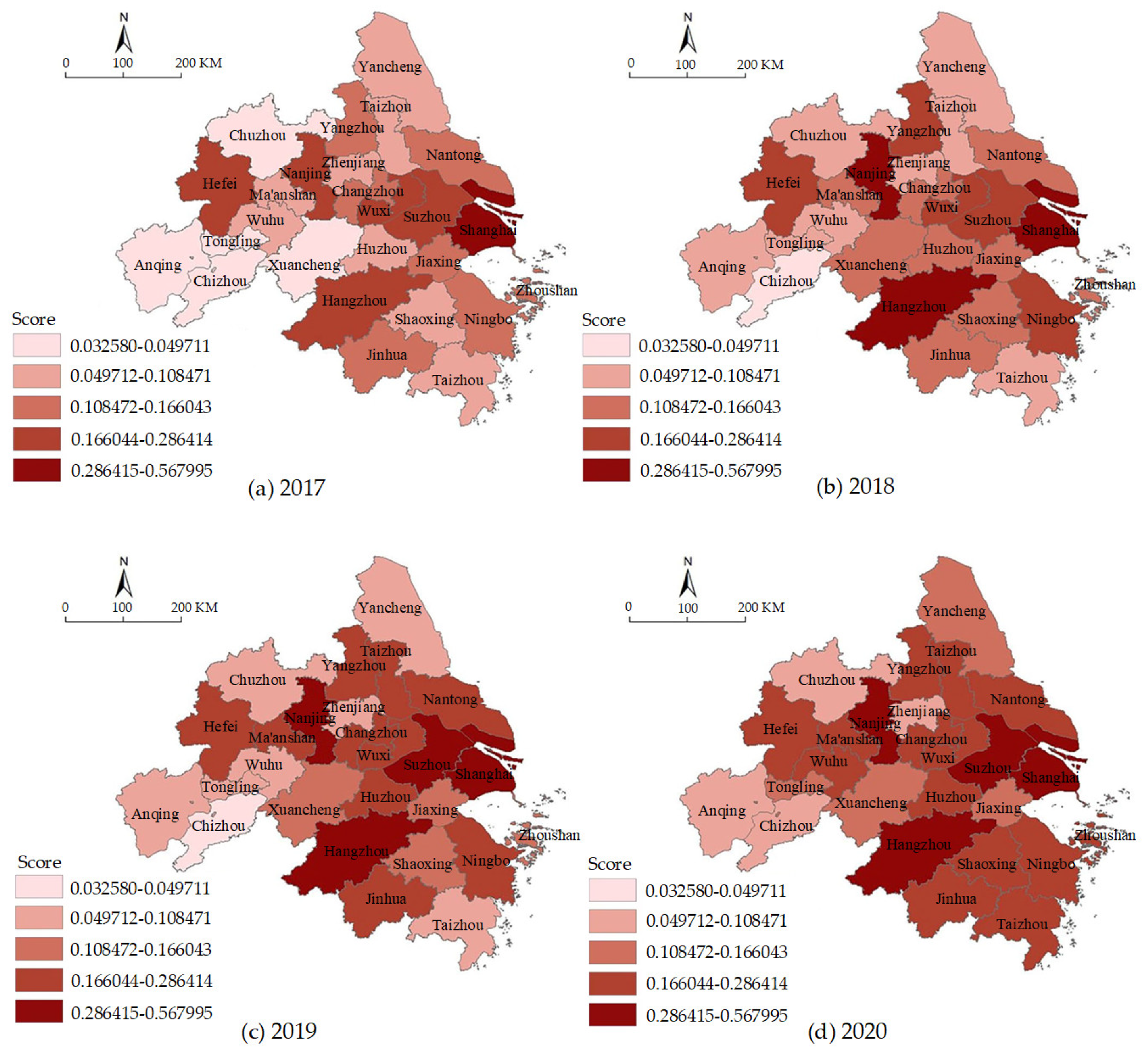
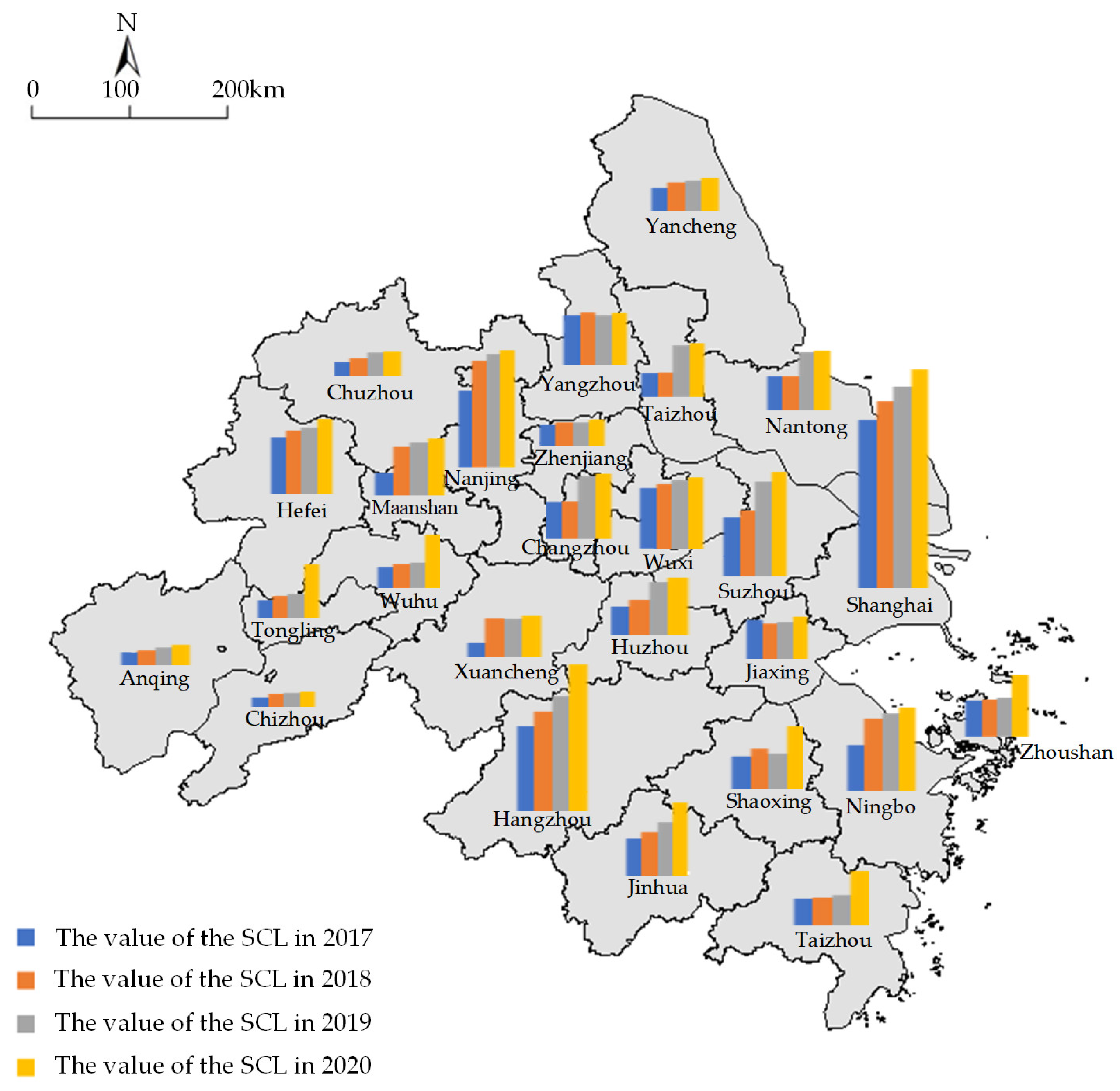

| Primary Indicators | Second-Level Indicators | Properties | References |
|---|---|---|---|
| Ecological livability (B1) | Rate of good ambient air quality/% | + | [3] |
| Per capita green areas/m2 | + | [22,23] | |
| Green coverage rate of built-up areas/% | + | [24] | |
| Sewage disposal rate/% | + | [24,25] | |
| Industry system (B2) | Number of employees in the ICT industry/person | + | [23,26] |
| E-commerce transaction amount/100 million yuan | + | [24] | |
| Ratio of added value of tertiary industry in GDP/% | + | [3,27] | |
| Number of high-technology industries | + | [3,27] | |
| Innovation capacity (B3) | Number of patent applications/items | + | [22] |
| Number of R&D personnel/person | + | [26] | |
| R&D expenditure as a percentage of GDP/% | + | [22,28] | |
| Number of higher education graduates/person | + | [22,28] | |
| Number of universities and colleges | + | [24] | |
| Public services (B4) | Inpatient hospital beds per 10,000 people/piece | + | [23,25] |
| Doctors per 10,000 people/person | + | [22,25] | |
| Proportion of per capita education expenditure/yuan | + | [26] | |
| Number of hospitals | + | [26] | |
| Information resources (B5) | Open data platforms | + | [24] |
| Satisfactory closing rate of disclosure application about government information/% | + | [29] | |
| Information openness of intelligent government | + | [23,30] | |
| Mechanism guarantee (B6) | Smart city planning | + | [22] |
| Security mechanisms | + | [22,25] | |
| Infrastructure system (B7) | Fixed broadband Internet access for users/person | + | [22,23,25,31] |
| Mobile Internet users/person | + | [22,23,25,31] | |
| Number of electric vehicle charging points | + | [32] | |
| Number of public libraries | + | [3,23] | |
| Social management (B8) | Unemployment rate/% | - | [3,22,23,31,33] |
| Per capita GDP/yuan | + | [26] | |
| Proportion of the population under minimum standard of living for city residents/% | - | [3] | |
| Engel’s coefficient/% | - | [3] |
| Primary Indicators | Weights | Second-Level Indicators | Code | Weights |
|---|---|---|---|---|
| Ecological livability (B1) | 0.0778 | Rate of good ambient air quality/% | X1 | 0.0057 |
| Per capita green areas/m2 | X2 | 0.0607 | ||
| Green coverage rate of built-up areas/% | X3 | 0.0103 | ||
| Sewage disposal rate/% | X4 | 0.0010 | ||
| Industry system (B2) | 0.2499 | Number of employees in the ICT industry/person | X5 | 0.0978 |
| E-commerce transaction amount/100 million yuan | X6 | 0.0945 | ||
| Ratio of added value of tertiary industry in GDP/% | X7 | 0.0047 | ||
| Number of high-technology industries | X8 | 0.0529 | ||
| Innovation capacity (B3) | 0.2449 | Number of patent applications/items | X9 | 0.0391 |
| Number of R&D personnel/person | X10 | 0.0899 | ||
| R&D expenditure as a percentage of GDP/% | X11 | 0.0079 | ||
| Number of higher education graduates/person | X12 | 0.0540 | ||
| Number of universities and colleges | X13 | 0.0540 | ||
| Public services (B4) | 0.0751 | Inpatient hospital beds per 10,000 people/piece | X14 | 0.0143 |
| Doctors per 10,000 people/person | X15 | 0.0096 | ||
| Proportion of per capita education expenditure/yuan | X16 | 0.0223 | ||
| Number of hospitals | X17 | 0.0289 | ||
| Information resources (B5) | 0.1698 | Open data platform | X18 | 0.0751 |
| Satisfactory closing rate of disclosure application about government information/% | X19 | 0.0014 | ||
| Information openness of intelligent government | X20 | 0.0933 | ||
| Mechanism guarantee (B6) | 0.0093 | Smart city planning | X21 | 0.0084 |
| Security mechanisms | X22 | 0.0009 | ||
| Infrastructure (B7) | 0.1237 | Fixed broadband Internet access for users/person | X23 | 0.0119 |
| Mobile Internet users/person | X24 | 0.0075 | ||
| Number of electric vehicle charging posts | X25 | 0.0773 | ||
| Number of public libraries | X26 | 0.0270 | ||
| Social management (B8) | 0.0497 | Unemployment rate/% | X27 | 0.0040 |
| Per capita GDP/yuan | X28 | 0.0242 | ||
| Proportion of the population under minimum standard of living for city residents/% | X29 | 0.0116 | ||
| Engel’s coefficient/% | X30 | 0.0099 |
| Year | Annual Average SCL | CV | |
|---|---|---|---|
| Value | Rate of Increase | ||
| 2017 | 0.137113 | -- | 0.788485 |
| 2018 | 0.163682 | 19.38% | 0.749971 |
| 2019 | 0.189333 | 15.67% | 0.706059 |
| 2020 | 0.22304 | 17.80% | 0.636717 |
| Gradient | Level | 2017 | 2018 | 2019 | 2020 |
|---|---|---|---|---|---|
| I | Excellent | 1 | 3 | 4 | 4 |
| II | Good | 5 | 5 | 10 | 14 |
| III | General | 7 | 9 | 4 | 4 |
| IV | Inferior | 8 | 8 | 7 | 4 |
| VI | Poor | 5 | 1 | 1 | 0 |
| Year | 2017 | 2018 | 2019 | 2020 |
|---|---|---|---|---|
| Moran’s I | −0.017698 | −0.080158 | −0.016605 | −0.032158 |
| z-score | 0.235568 | −0.405860 | 0.229104 | 0.076560 |
| p-value | 0.813768 | 0.684845 | 0.818788 | 0.938973 |
Disclaimer/Publisher’s Note: The statements, opinions and data contained in all publications are solely those of the individual author(s) and contributor(s) and not of MDPI and/or the editor(s). MDPI and/or the editor(s) disclaim responsibility for any injury to people or property resulting from any ideas, methods, instructions or products referred to in the content. |
© 2023 by the authors. Licensee MDPI, Basel, Switzerland. This article is an open access article distributed under the terms and conditions of the Creative Commons Attribution (CC BY) license (https://creativecommons.org/licenses/by/4.0/).
Share and Cite
Gu, T.; Liu, S.; Liu, X.; Shan, Y.; Hao, E.; Niu, M. Evaluation of the Smart City and Analysis of Its Spatial–Temporal Characteristics in China: A Case Study of 26 Cities in the Yangtze River Delta Urban Agglomeration. Land 2023, 12, 1862. https://doi.org/10.3390/land12101862
Gu T, Liu S, Liu X, Shan Y, Hao E, Niu M. Evaluation of the Smart City and Analysis of Its Spatial–Temporal Characteristics in China: A Case Study of 26 Cities in the Yangtze River Delta Urban Agglomeration. Land. 2023; 12(10):1862. https://doi.org/10.3390/land12101862
Chicago/Turabian StyleGu, Tiantian, Shuyu Liu, Xuefan Liu, Yujia Shan, Enyang Hao, and Miaomiao Niu. 2023. "Evaluation of the Smart City and Analysis of Its Spatial–Temporal Characteristics in China: A Case Study of 26 Cities in the Yangtze River Delta Urban Agglomeration" Land 12, no. 10: 1862. https://doi.org/10.3390/land12101862
APA StyleGu, T., Liu, S., Liu, X., Shan, Y., Hao, E., & Niu, M. (2023). Evaluation of the Smart City and Analysis of Its Spatial–Temporal Characteristics in China: A Case Study of 26 Cities in the Yangtze River Delta Urban Agglomeration. Land, 12(10), 1862. https://doi.org/10.3390/land12101862










